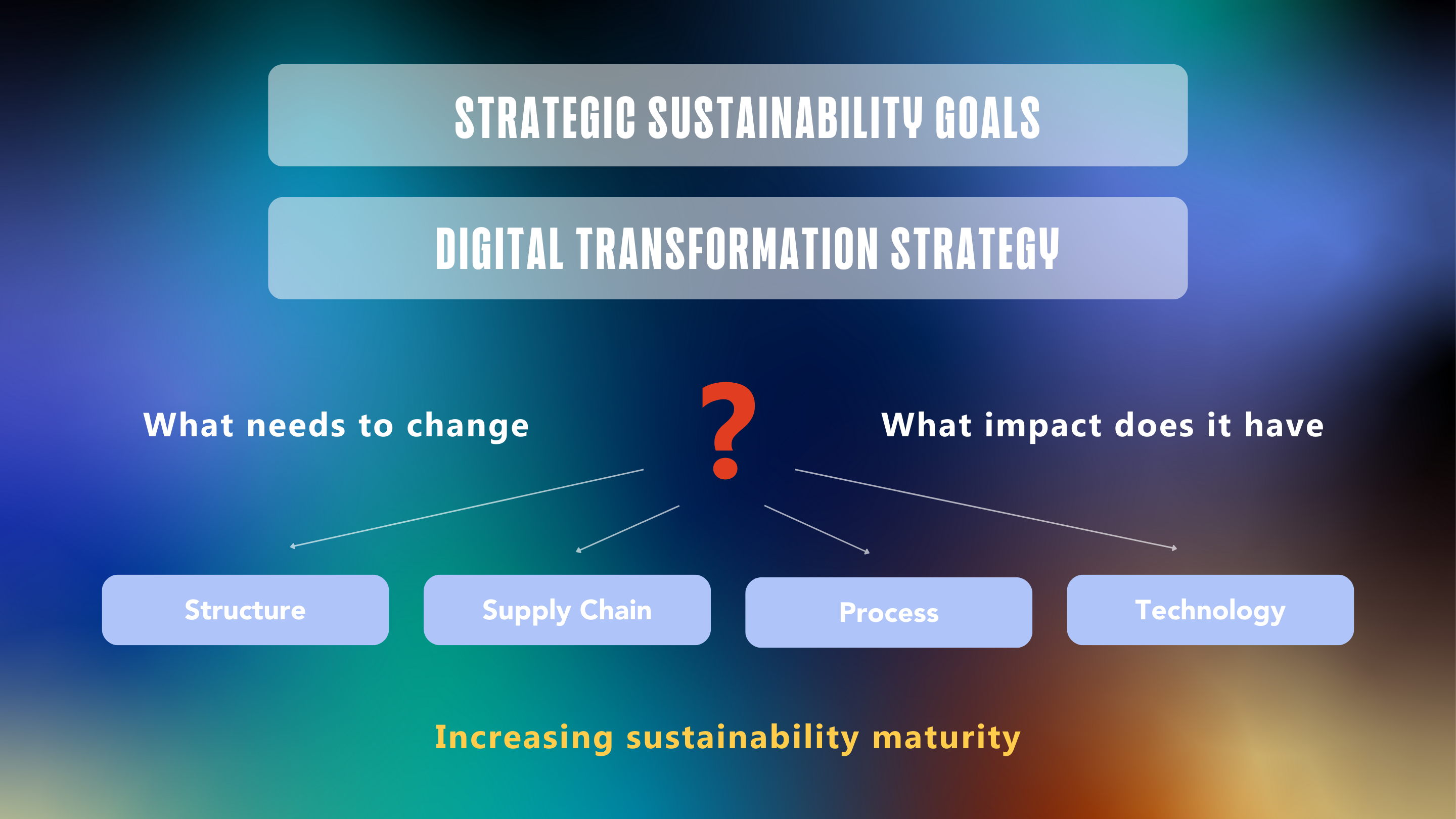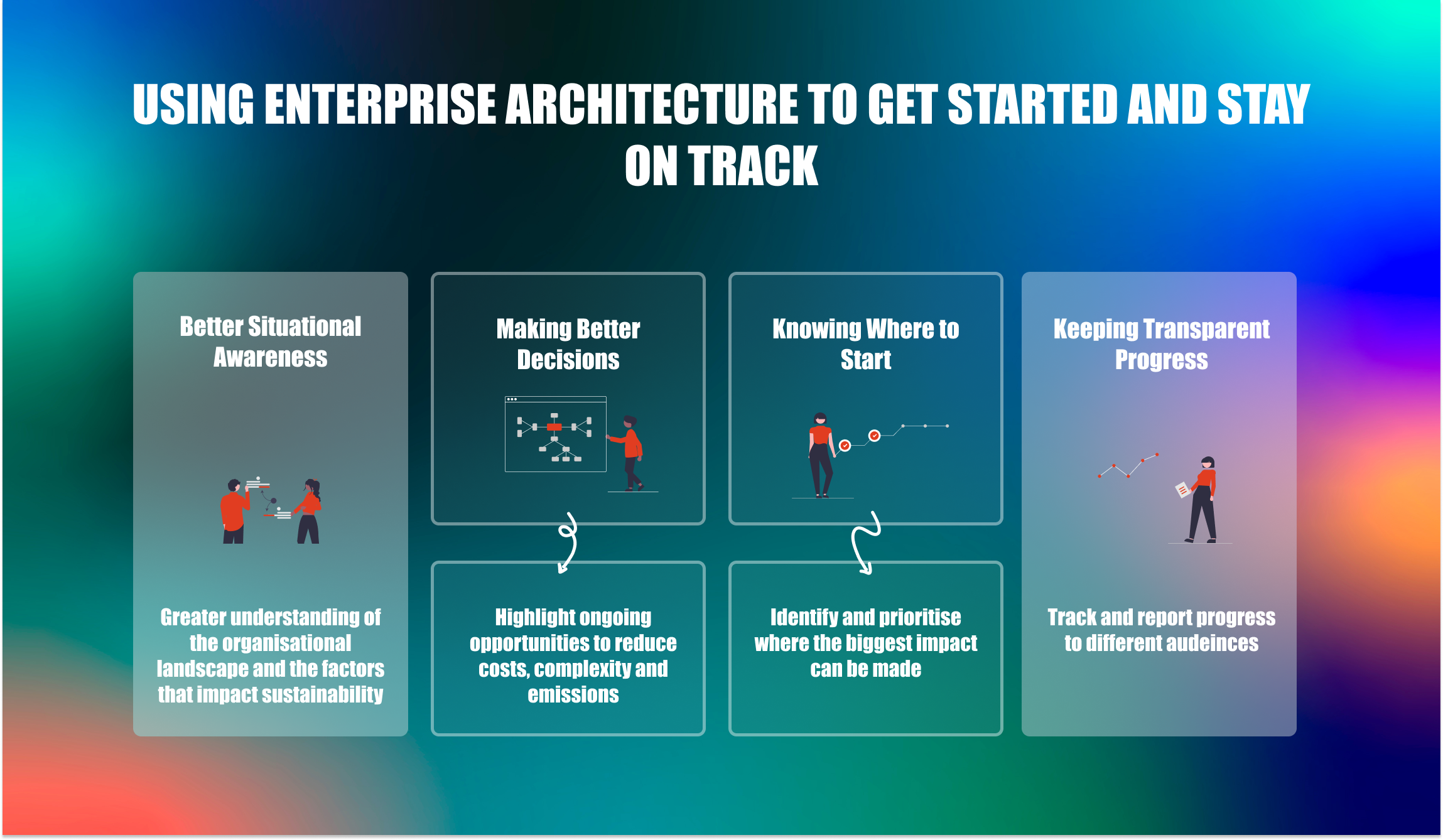In a previous Enabling Sustainability article we highlighted the importance of incorporating sustainability within your digital transformation strategy and how incorporating sustainability within governance processes can drive good decisioning making.
With sustainability objectives firmly included within your digital transformation strategy, the next challenge is understanding how to start and know you are prioritising the right things. This article explains the vital role Enterprise Architecture can play in helping to prioritise, track and drive your sustainability initiatives.
A familiar problem
It is a familiar problem. Given a strategic objective, what do you tackle first and why? And how do you know you are making a positive difference?
While your digital transformation strategy includes objectives, metrics and a roadmap for improving sustainability – what does that practically mean for how a department should change, what processes should be targeted, which suppliers replaced, or technology systems modernised?
Ask three different colleagues how they would suggest going about it and you will be given three different viewpoints, each reflecting individual experience, knowledge, role or even personal interest.
Each viewpoint on sustainability will likely offer a different:
- Reason
Sustainability may be viewed as being the right thing to do, necessary to meet a legal requirement or providing a new line of revenue.
- Starting point
Each starting point will reflect individual priorities and their knowledge of the organisation’s current level of maturity with regards to sustainability and the need and potential for change.
- Approach
Different roles will encounter and think about sustainability in unique ways, relying on individual experience to identify the actions to address it.
- Sharing progress
Based on their role, individuals will have a different daily experience of technology, tools and reporting that varies how progress is visible and communicated.
With such different viewpoints it can be difficult to understand what to prioritise, what actions offer the greatest return on investment, and how best to ensure progress is visible.

Breaking down the problem
At FSP we understand that the key to addressing a difficult problem is to break it down into smaller pieces, to the point where each piece is understandable, quantifiable, and actionable. This helps remove the subjective influence of personal experience and concentrates on objective value and measures.
We also believe that sustainability objectives and metrics can, and should, be treated in the same way as cost or risk. For example, sustainability benefit can be quantified in terms of reduced emissions and estimated and tracked through a model in a similar way to cost. In the same way that risk mitigations can be identified and tracked, so can sustainability actions e.g. choosing to reduce environmental impact for part of an organisation or service by 25%, avoid it entirely through a green alternative or transfer it e.g. invest in carbon offset.
Enterprise Architecture (EA) plays a crucial role in tackling sustainability challenges by providing a structured and strategic approach to aligning business goals with sustainable practices. Through systematic analysis and design methods, EA enables organisations to optimise their processes, technologies, and resources to reduce environmental impacts, improve resource efficiency, and support long-term sustainability.
A typical EA function will create and maintain a catalogue of the business functions and corresponding technology systems across the organisation. Having this structure immediately allows a strategic objective to be broken down across departments/functions, and flow down to an individual system or supplier that is supplying the service. And vice-versa from bottom-up.
A good EA should already include metadata attributes that capture and label capabilities, systems and applications e.g. cost, support status, business criticality, supplier and security level so they can be assessed as factors as part of change impact analysis. Sustainability is readily included with these as an additional attribute.
Addressing the problem
So how can we use EA to address sustainability and our initial problem of deciding how to start, what approach to take and how to track progress?
Better situational awareness
It is important to remember that our strategic objectives set out a target vision that has been shaped and informed by:
- The level of sustainability maturity the organisation is starting from
- External and internal factors that require specific action or limit options.
These may include the results of a maturity assessment, environmental reports on current position, government emissions mandates or policies, sustainability charters that the organisation has signed-up to or broader industry targets.
The organisation’s position on sustainability should also be understood – is the priority for the organisation to be a leader, an enthusiastic follower, a minimal complier, driven by customer demand or central to a corporate vision?
EA plays a key role in interpreting these factors, ensuring that they are clearly understood and applied as principles that guide change in support of the sustainability objectives. Maintaining awareness of these helps to ensure that decisions are made not only with the objectives in sight, but also with a practical context that guides the options available.
Knowing where to start
By breaking down the organisation’s functions and systems into a hierarchical structure we immediately have a map upon which we can layer a sustainability view of the organisation.
For example, we can take a strategic target of reducing carbon emissions by 25% and distribute that target across the organisation, assigning an estimated target percentage to specific departments/products/services and to the underlying suppliers and systems. That immediately provides an ability to assess the sustainability impact of changing one of the mapped elements. Combined with cost and risk it enables a rounded assessment of cost, risk and sustainability to be analysed, supporting prioritisation.
For example, an expensive, manual and paper-based non-core business function will likely offer a better opportunity to deliver against sustainability targets than a portfolio of system applications recently rationalised and moved to the cloud.
Therefore, using EA to establish the mapping and including sustainability attributes enables quantifiable and educated decisions on prioritisation to be made.
Making better decisions
Once initial priorities have been decided and programmes and projects kicked-off, an EA informed approach helps decide what action to take. Because our breakdown and mapping has categorised organisation and Information Technology components and their status, it immediately supports understanding of practical sustainability actions that can be undertaken.
For example, clarity across an application portfolio can highlight opportunities to rationalise duplicate capabilities thereby reducing complexity, cost and emissions. Alternatively, related services that rely on overseas suppliers may be more environmentally delivered by a UK-based supplier who generates fewer emissions. Time and effort are therefore not wasted exploring or pursuing impractical and ineffective options, and EA helps identify efficient patterns for consolidation or reuse that can be built up over time.
Keeping progress transparent
Successfully achieving strategic sustainability objectives will ultimately affect all employees, either directly or through the dependencies they have on processes, technology or suppliers.
Key to ensuring engagement across the organisation is being able to track and communicate progress in context and at levels that are appropriate to different employees. In the same way as organisation performance measures such as sales figures, new customers or employee numbers are made visible through reports or updates.
Enterprise Architecture provides a breakdown and mapping of organisational units, systems and components that includes sustainability metadata against each item. Progress and performance can be updated, tracked and reported for different audiences, e.g., by department, business function, hosting location, system or physical location. The results can be communicated, and made visible and relevant for each employee.
Conclusion
Many organisations face new challenges in meeting their sustainability objectives – scale, legacy estate, experience and goals are all obstacles to knowing where to start, what to action and how to capture progress.
The good news is that proven Enterprise Architecture approaches and techniques already enable sustainability to be incorporated as another factor that is captured, tracked, assessed and reported on, when undertaking strategic change and digital transformation. Sustainability provides an opportunity for organisations to refresh their approach to EA and ensure that sustainability is included by default as a consideration, and potential opportunity to achieve more, when addressing strategic change.
Breaking down your business and technology ecosystem into quantifiable views on business capability and function, and technology systems and applications provides the basis upon which to do so.
A combination of updating your approach to the problems Enterprise Architecture can address, updating your thinking across the organisation and supporting it with appropriate tooling can deliver the maintainable framework and momentum necessary to successfully achieve sustainability goals.
Partnering with FSP for a Sustainable Future
If you want to explore other enablers for achieving sustainable digital transformation, we invite you to check out our white paper which also contains pragmatic advice for digital leaders looking to find out more about sustainability and how it can benefit their transformation initiatives. Feel free to get in touch with us at sustainability@fsp.co to find out more about these topics and discuss how we can help your organisation thrive in the realm of sustainability.

